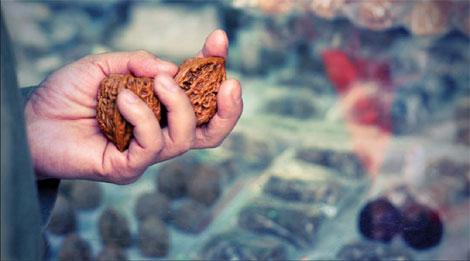Wow nut
Updated: 2011-12-30 07:42
By Yin Yin (China Daily)
|
|||||||||
|
Playing with Wenwan walnuts, a hand movement exercise passed down from ancient China's Han Dynasty, is said to be helpful for keeping healthy. Zhang Shiyue / For China Daily |
A collectible item that dates back to imperial times is treasured for its looks and powers
Chen Yongren, a retired teacher, is 76, but many say he looks much younger. The kernel of his longevity, he says, is the humble walnut. "Every day for the past 20 years I have rubbed and rotated two walnuts in my palm. The hand movements exercise my brain and slow down aging. I spent long periods sitting at a desk when I was working at school. Playing with the nuts has helped prevent any ailments I might have suffered as a result."
The sprightly retiree is just one of many Chinese who swear by walnuts - not as a healthy snack as thought of in the West, but as an exercise tool.
The collectible nuts, known as Wenwan walnuts, are a separate strain from common walnuts that are eaten and are considered more elaborate in texture and color. The best Wenwan walnuts are said to come from the mountainous areas near Beijing, Tianjin and Hebei province.
Wenwan walnuts date back to the Han Dynasty (206 BC-AD 220) and became widespread in the Tang Dynasty (AD 618-907). Records show that there was an emperor of the late Ming Dynasty (1368-1644) who was so addicted to playing with the nuts that he ignored state affairs. The walnuts became an extremely popular hobby in the Qing Dynasty (1644-1911). From emperors and ministers to aristocrats and savvy urbanites, many Chinese people carried a pair of Wenwan walnuts with them wherever they went.
Playing with the nuts soon became a status symbol. The nobles regarded Wenwan walnuts as an essential item, and ministers picked the best ones as a tribute to their rulers. The trend trickled down to the man on the street and many soon regarded the walnuts as fashion items.
Aisin-gioro Pu Yi, the last emperor of China, also mentioned Wenwan walnuts in his autobiography, The First Half of My Life. He found a pair of Wenwan walnuts in the Forbidden City, which were later discovered to belong to the Qing Emperor Qianlong. Many say the walnuts never left the hands of Qianlong, who reigned the country for six decades and is considered to be one of the longest reigning monarchs of imperial China.
Senior Beijingers still believe Wenwan walnuts are a treasure passed down from the Qing royalty.
"In traditional Chinese medicine, there are many acupoints on the palm. If you press and stimulate them regularly, they will have a positive effect on your internal organs," Chen says.
"Playing and exercising with Wenwan walnuts can also help prevent cardiovascular disease, stroke and other chronic diseases."
The Palace Museum now preserves many precious Wenwan walnuts that were most used by the emperors. Their colors range from reddish brown to those similar to exquisitely carved rosewood. A pair of walnuts used by Qianlong is valued at 170,000 yuan ($26,800, 20,600 euros).
"My walnuts were very cheap when I bought them. But after rubbing, twirling and kneading them for several years, the chemical reaction they have with your hand leaves the surface of the nuts beautifully polished. Their color also changes, from yellow to brown, then to reddish and finally dark red," Chen says.
"Their texture also changes with time - from that of wood to rock, then porcelain and agate. This is why Wenwan walnuts are so valuable."
Wenwan collectibles can be very expensive. In some antique markets of Beijing, Wenwan walnuts are one of the hottest items. Their popularity is fueled by many enthusiastic fans.
"It takes great effort to find a pair of Wenwan walnuts. It can be very difficult to find pairs of similar texture, size and even weight," says Zhang Jianxin, a vendor at the Beijing Panjiayuan antique market.
Wenwan walnuts fall into three general categories: iron, qiuzi and ma. The iron ones are those commonly sold in markets. They are large and have a shallow texture and small cusp. The qiuzi, mostly from Northeast China, are more slender. "The ma are the most sought after," Zhang says. "They include what are called lion heads, luohan heads, official hats and chicken hearts. The lion head, as the name suggests, boasts beautiful, elaborate patterns and can sport holes that look like its eyes. Lion heads are very popular among collectors, who will pay a lot for them. I once sold a pair of lion heads for 80,000 yuan."
According to the Walnut Note, an ancient Chinese treatise dedicated to Wenwan nuts, the lion head is a rare species and grows mostly in the wild. Connoisseurs say its plump figure, flat bottom and smooth shell make it very comfortable to play with. Lion heads are also popular for hand therapy.
"Other Wenwan walnuts can be cheaper but there are also good varieties such as lanterns, peach hearts, date pits and eagle mouths," Zhang says. "No matter the type of Wenwan walnut, the skill needed to select them is still done through their texture, shape, color and weight."
Still, many walnuts deemed bizarre by traditional standards attracted collectors' attention. These have been attributed to advanced grafting techniques and natural variation in their appearance that produce "abnormal nuts".
"I used to prefer the lion head and spent a lot of money for them. They had exquisite texture and body," says Li Yi, an antique collector. "But I accidentally found a pair of peculiar walnuts which were shaped like water drops. After that, I began to collect 'bizarre ones' like these."
The abnormal walnuts have become increasingly more valuable as more practitioners get used to them. "Sometimes, these bizarre walnuts are more expensive than the common variety, even the lion heads. I have a couple of them and their shapes are a perfect match, like conjoined babies," Li says.
"Many collectors think that the abnormal nuts are deformed, but I believe that, regardless of their varieties, interest and passion for the Wenwan walnuts are the most important factors for collecting and using them."












